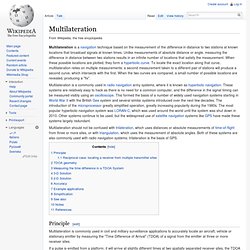Cross Correlation
> Michaelb01
> Leeds University
> MME Project
> Sound Localisation
Cross Correlation. The complex cross correlation of f(x) with g(x) is defined as The definition can also be written as after changing the dummy variable of integration.

The corresponding definition of cross correlation for sequences would be Some authors define cross correlation as The corresponding definition for sequences would be The Matlab function xcorr uses the second definition. Example 1 Use the following real input sequences: x = [1 2 3 4]; y = [-1 2 1 -1]; Matlab convolution: conv(x,y) ans = -1 0 2 3 9 1 -4 The following should be the first definition of cross-correlation: conv(x,fliplr(y)) ans = -1 -1 1 2 8 5 -4 This should be the second definition of cross-correlation: conv(fliplr(x),y) ans = -4 5 8 2 1 -1 -1 and indeed it does match the results of xcorr: xcorr(x,y) ans = -4.0000 5.0000 8.0000 2.0000 1.0000 -1.0000 -1.0000 Fourier Transform of Cross-Correlation Function Using the first definition of cross correlation, we can find its Fourier transform as Example 2.
Fft - How do I implement cross-correlation to prove two audio files are similar? - Signal Processing - Stack Exchange. Cross-correlation and convolution are closely-related.

In short, to do convolution with FFTs, you zero-pad the input signals (add zeros to the end so that at least half of the wave is "blank")take the FFT of both signalsmultiply the results together (element-wise multiplication)do the inverse FFT conv = ifft(fft(a and zeroes) * fft(b and zeroes)) You need to do the zero-padding because the FFT method is actually circular cross-correlation, meaning the signal wraps around at the ends. So you add enough zeros to get rid of the overlap, to simulate a signal that is zero out to infinity.
To get cross-correlation instead of convolution, you either need to time-reverse one of the signals before doing the FFT, or take the complex conjugate of one of the signals after the FFT: corr = ifft(fft(a and zeroes) * fft(b and zeroes[reversed]))corr = ifft(fft(a and zeroes) * conj(fft(b and zeroes))) whichever is easier with your hardware/software.
Doa_gcc2.m - TDE TIME DELAY ESTIMATION... - Source Codes Reader - HackChina. Multi-microphone signal processing. This page provides source code for several blind multi-microphone speech enhancement techniques.

These were implemented by Marc Ferras while pursuing his Masters thesis on multi-microphone signal processing for automatic speech recognition in meeting rooms. These techniques were evaluated on the ICSI Meeting Recorder Digits (MRD) Corpus, which can be downloaded here. The Beamformit beamforming toolkit may also be of interest. This work was developed during Ferras' visit at ICSI in 2004-2005 and funded by the Augmented Multiparty Interaction (AMI) training program. (David Gelbart's involvement as an unofficial co-advisor was funded by the SmartWeb project.)
Multilateration. Multilateration is a navigation technique based on the measurement of the difference in distance to two stations at known locations that broadcast signals at known times.

Unlike measurements of absolute distance or angle, measuring the difference in distance between two stations results in an infinite number of locations that satisfy the measurement. When these possible locations are plotted, they form a hyperbolic curve. To locate the exact location along that curve, multilateration relies on multiple measurements: a second measurement taken to a different pair of stations will produce a second curve, which intersects with the first. When the two curves are compared, a small number of possible locations are revealed, producing a "fix". Multilateration should not be confused with trilateration, which uses distances or absolute measurements of time-of-flight from three or more sites, or with triangulation, which uses the measurement of absolute angles.
Principle[edit] Fig1. Fig 2. ). And. Lab8.pdf. Autocorrelation and Crosscorrelation in Matlab. MATLAB PROGRAM FOR CROSS-CORRELATION (DIGITAL SIGNAL PROCESSING)




